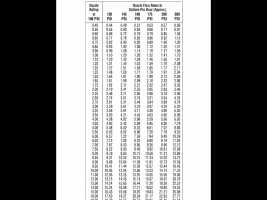Hello forum. I'm stuck trying to solve a problem. I hope I'm in the right forum. To keep it short, I'll post the problem. I am more than happy to provide more information.
The formula is a way to calculate flow rate based on an orifice size and pump pressure for heating oil nozzles.
x*(y/100)^.5
As an example, when
x=.75
y=145
The answer rounded to 2 decimal places is .90 Works fine.
So where I'm stuck...
What I am trying to figure out is a new formula that uses the previous result of .90, and if I change x to .65 get this new formula to provide an answer that calculates for y.
With the above numbers, when I change x to .65 in this new calculation, solving for y should equal 190. I can back into it with the first formula by consistently changing y until I get the .90 answer.
Trying to put is simpler terms, if I know the flow rate needed (.90 based on the first calculation) I want to know (figure out) if I select a smaller orifice (.65), what pump pressure will I need to maintain that flow rate (190).
Thanks for reading!
Steve
The formula is a way to calculate flow rate based on an orifice size and pump pressure for heating oil nozzles.
x*(y/100)^.5
As an example, when
x=.75
y=145
The answer rounded to 2 decimal places is .90 Works fine.
So where I'm stuck...
What I am trying to figure out is a new formula that uses the previous result of .90, and if I change x to .65 get this new formula to provide an answer that calculates for y.
With the above numbers, when I change x to .65 in this new calculation, solving for y should equal 190. I can back into it with the first formula by consistently changing y until I get the .90 answer.
Trying to put is simpler terms, if I know the flow rate needed (.90 based on the first calculation) I want to know (figure out) if I select a smaller orifice (.65), what pump pressure will I need to maintain that flow rate (190).
Thanks for reading!
Steve

